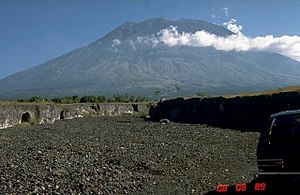Gunung Agung: Béda antarrépisi
alihbasa tacan lengkep |
m robot Adding: fr:Agung (volcan) |
||
| Baris ka-45: | Baris ka-45: | ||
[[en:Mount Agung]] |
[[en:Mount Agung]] |
||
[[et:Agung]] |
[[et:Agung]] |
||
[[fr:Agung (volcan)]] |
|||
[[id:Gunung Agung]] |
[[id:Gunung Agung]] |
||
| ⚫ | |||
[[ja:アグン山]] |
[[ja:アグン山]] |
||
| ⚫ | |||
[[pl:Agung]] |
[[pl:Agung]] |
||
Révisi nurutkeun 25 Maret 2007 17.03
| Gunung Agung | |
|---|---|
 Gunung Agung taun 1989 | |
| Luhur | 3,031 méter (9,944 suku) |
| Perenah | Bali, Indonesia |
| Koordinat | |
| Tipe | Stratovolcano |
| Panungtungan bitu | 1964 |
| Rute panggampangna | leumpang |
Gunung Agung nyaeta salasahiji gunung di Bali, Indonésia. Dina 3,142 m saluhureun laut, stratovolcano ieu mangrupakeun gunung pangluhurna di Pulo Bali. Gunung ieu aya di Kacamatan Rendang, Kabupatén Karangasem, Propinsi Bali.
|
|
Artikel ieu keur dikeureuyeuh, ditarjamahkeun tina basa Inggris. Bantuanna didagoan pikeun narjamahkeun. |
Gunung Agung is still active, with a large and very deep crater which occasionally belches smoke and ash. From a distance, the mountain appears to be perfectly conical, despite the existence of the large crater.
From the peak of the mountain, it is possible to see the peak of Gunung Rinjani on the island of Lombok, although both mountains are frequently covered in cloud. The best time to climb the mountain is at dawn when the air is still clear, giving spectacular views.
Naék gunung
There are three major approaches to the mountain. From the south, south-east, and from the west. The western approach is the most commonly taken path, as it leads from the Temple of Besakih. It also has spectacular views along the length of the trail. It is important that hikers take their own water with them as the only source of water on the trail is a well that is considered holy and therefore forbidden. Much of the climb is loose soil and rock, so climbers are encouraged to use adequate footwear.
Bitu taun 1963-64
The lava flows missed, sometimes by mere yards, the Mother Temple of Besakih. The saving of the temple is regarded by the Balinese people as miraculous and a signal from the gods that they wished to demonstrate their power but not destroy the monument the Balinese faithful had erected. However, over 1,000 people were killed and a number of villages were destroyed in this eruption.

Tempo oge
Tumbu luar
| Artikel ngeunaan Indonésia ieu mangrupa taratas, perlu disampurnakeun. Upami sadérék uninga langkung paos perkawis ieu, dihaturan kanggo ngalengkepan. |
